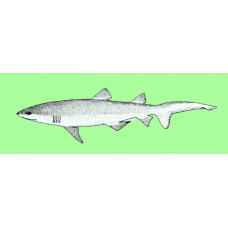Latin name
Carcharias tricuspidatus
Other name
Carcharias tricuspidatus
Identification
Carcharias: From the Ancient Greek karkharías, shark, derived from kárkharos, sharp or jagged, referring to a shark’s teeth; tricuspidatus: -atus (L.), provided with: tricuspid teeth, referring to how “awl-shaped” teeth have a “small basal cusp” (or cusplet) on both sides of smooth main cusp.
The appearance of the Indian sand tiger is little different from that of the sand tiger shark. They have a massive body, large head, small eyes without lashes and fang-like, randomly curved teeth. The main differences are the absence of periorbital folds and the rounded shape of the snout.
Features of fish fins
The dorsal fins are of equal size, the posterior dorsal fin being almost equal in size to the anal fin. The caudal fin has a more developed upper lobe carrying a pennant.
Fish colouring
The dorsal colouration is light brown to yellowish grey with a pale belly separated by sharp edges. There are small dark brown patches on the back and flanks which fade with age.
Distribution
Widespread in the Indian Ocean: India and Pakistan. Possibly in Indonesia, Indochina, Australia, the Philippines and northern China.
Habitat
A type of shark that lives on the bottom of tropical oceans.
Size
The maximum length of males is 370 cm, the usual length is 280 cm.
Behavior
They are nocturnal. During the day they hide near rocks, ledges, caves and reefs.
Food and feeding habits
The diet of these fish is based on bony fish, small cartilaginous fish and cephalopods.
Reproduction
The Indian sand tiger breeds by oviparity. They have pronounced intrauterine cannibalism.
Fishing
This species is not commercially important.
Relationship with a person
The Indian Sand Tiger is considered a dangerous shark to humans.
| Classification | |
| Phylum | Chordata |
| Class | Chondrichthyes |
| Squad | Lamniformes |
| Family | Carchariidae |
| Genus | Carcharias |
| Species | C. tricuspidatus |
| Features | |
| Conservation status | Not Evaluated |
| Habitat | Pelagic |
| Life span, years | No information |
| Maximum body weight, kg | No information |
| Maximum length, cm | 370 |
| Sailing speed, m/s | No information |
| Threat to people | Edible |
| Way of eating | Predator |
Indian sand tiger
Tags: indian sand tiger

